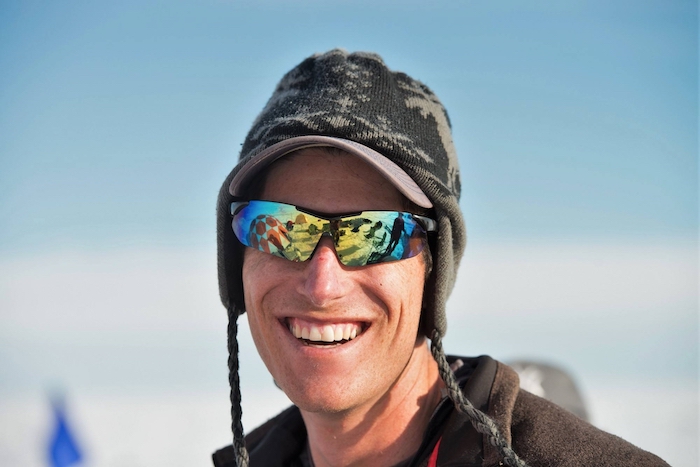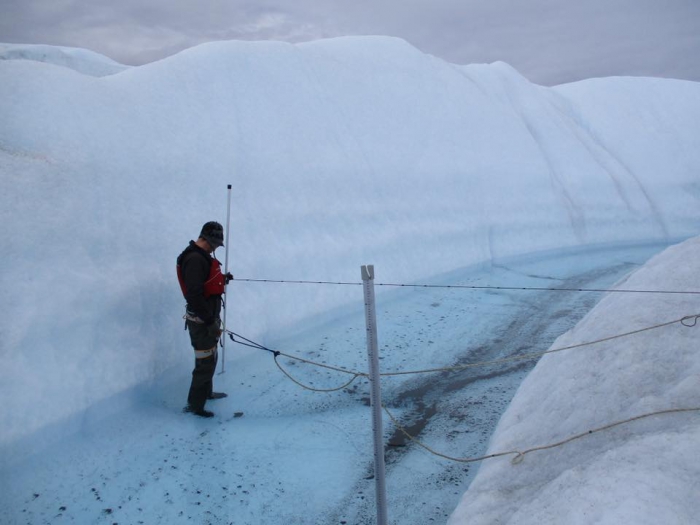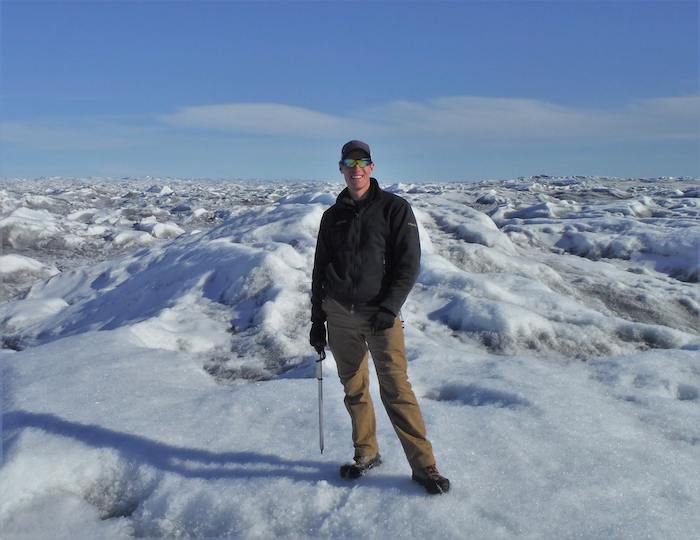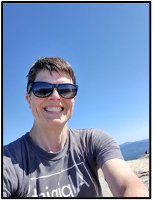By: Katherine Schexneider, ARCUS Volunteer
Editor's Note: A new ARCUS Member Profile product is featured in this interview between ARCUS volunteers Katherine Schexneider and Sasha Leidman. This interview and the Member Profile are the first in a new series developed to highlight the work of our individual members and help ARCUS members get to know one another, by supporting connections across disciplines, communities, and career paths.
Download Member Profile (PDF - 2.5 MB)
Katherine Schexneider and Sasha Leidman are both volunteer members of the ARCUS Membership and Development (MEMDEV) Committee.

Katherine: Welcome, Sasha Leidman. Help me remember what your particular area of expertise and role is at Rutgers University.
Sasha: I'm a Ph.D. candidate in the Department of Geography at Rutgers. I like to call myself a glacial hydrologist. My research focuses on how ice sheets dispel their water by looking at different hydrologic systems such as superficial streams and proglacial lakes to see how they connect and how they impact climate regimes.
Katherine: Where are you in the Ph.D. process? I understand it's a long and challenging one.
Sasha: I'm about to start my fifth year, so hopefully coming to a close soon. This will be my last year, finishing everything up.
Katherine: How did you find you way into glacial hydrology? What made a glacier jump out at you?
Sasha: When I went into college, I knew I wanted to study rivers. I was big into whitewater kayaking and rafting and worked as a rafting guide for several years. That got me hooked on geomorphology, especially fluvial geomorphology. Then, after my sophomore year as an undergrad, I joined the Juneau Ice Field Research Program (JIRP) and fell in love with glacial landscapes. My research now combines my two loves: the incredibly beautiful Arctic landscapes and the power and physics of hydrology.
Katherine: We talk sometimes about how people may not necessarily have an interest in a topic, but then they connect with the people that are instructing. Was there something particular about the Juneau Ice Field Program people you worked with that made you say, "Hey, I really like this person and what they're doing, and I want to follow along with them and maybe continue to work with them at some point?"
Sasha: Definitely. I think the Juneau Ice Field Program more than any other I've experienced, truly respects how important field work is for education. They use the landscape as a teaching mechanism. We would go out on hikes to learn about the geology, different land forms, and the ice that we saw. It was an incredibly respectful and fun environment to be in. You're a bunch of college kids camping out on an ice field. What could be more fun than that? And getting to do amazing things like practicing crevasse rescues and skiing across a huge snow field, and so that combination of great interesting people, doing fun things together learning in the process, a perfect storm.

Katherine: Now we're always thinking about interdisciplinary work, how what a glacial hydrologist does connects with what a person in the microbiome community or the infrastructure community. At your point, have you had a chance to experience some of that yet?
Sasha: The hydrology community is one that could use some more branching out, but I really enjoy getting to experience other fields, especially social scientists. One thing you learn as a glacial hydrologist is that water affects everybody, so in order to truly understand the environment you work in, you have to understand the people that rely on that water. Even in Greenland where there are these tiny towns with gigantic rivers, we need to know exactly what the uses of that water is, and how changes in that system will affect not just the local community, but the global community. We work with atmospheric scientists, with geologists, with all sorts of mechanics. It's really working with social scientists that helps motivate our work.
Katherine: I'm excited to see how interdisciplinary work is being championed and continuing. My career was in medicine as a physician and during my career, I saw physicians in different specialties working together, physicians and nurses and technicians and pharmacists and everyone coming together to share their knowledge and bring healthcare more to the patient, so it seems like we're seeing the same thing here, and that's great. What is the particularly exciting part of the work you've done so far? Sounds like field work is pretty keen.
Sasha: I've had the privilege to do a lot of field work. Even in undergrad, I took every opportunity I could and do field work. We were hoping to go out this past season. It would have been my eighth time to Greenland. What gets me out of bed every day and gets me interested in doing more work on glaciers is the opportunity to actually be on the glaciers.
Katherine: I've heard you've gone to Greenland a number of times. It's one of the places I want to go and explore. What was the experience like in Greenland?
Were you quite remote in a small village, or based in Nuuk? What did that look like?
Sasha: We were based in the town of Kangerlussuaq in Southwest Greenland and would fly in on a military cargo plane out of Albany, New York. Kangerlussuaq is a lovely town with a very interesting history. Unlike any other town in Greenland, it was founded by the US military specifically for its military importance because it is right next to the ice sheet. It's in an incredible rain shadow and gets very little rain, so it's very easy to land a plane there. It's got one of the largest runways in all of the Arctic, and it's at the end of the longest fjord in the world, so you can get incredibly inland but still be on the ocean which is definitely strategic. That kind of reflects on how the town is made up. There are these large rectangular, militaristic looking buildings, and yet it's occupied by Greenlandic people. There's a kindergarten there. You'll see kids running around all the time. And so, it's got this storied militaristic past, but it's filled with these incredibly kind and helpful people.
Katherine: There's no longer a military presence there?
Sasha: Both the Danish military and the US National Guard are stationed there It's purely for training purposes.
Katherine: I was listening to a podcast on the relationship between Iceland and Greenland and was really intrigued by the presentation of Greenland by their state department representative. He described it as a modern country, on the rise, plugged into modern technology and ready to be a player on the world stage, or the Arctic stage or the Scandinavian stage. Did you get a feel for that there?
Sasha: Absolutely. Greenland is a very unique place in terms of governance and its relationship with Indigenous rights in the Arctic. While it's a very small population, it's one of the few places in the Arctic where the majority of the people are Indigenous. That autonomy isn't present anywhere else. You see that really manifest in some of the local politics. One of the largest issues in this past election was the opening of a uranium mine in Southern Greenland. We saw there was a Chinese and New Zealand company trying to open up this mine. Overwhelmingly, the population voted for candidates who opposed to the mine, and the mine went dead on arrival. We saw that the population was very much in favor of expansion of the economy with mining and fishing and other related economies, but want to make sure that they have as control of development as much as possible.
Katherine: Now, let's jump to your non-work life. You certainly do a lot of travel for your work. Where do you go for vacation? What do you go when you're not camping on glaciers?
Sasha: Usually camping on dirt. I love the outdoors and take any opportunity I can to get outside. I worked as a backpacking and rock-climbing guide, whitewater rafting guide all through college, and as well when I came to Rutgers. I spent two of my summers in college backpacking the Pacific Crest Trail.
Katherine: You did the Pacific Crest Trail? You completed the whole thing in two summers? That's awesome.
Sasha: I try to get out. We just got back from a road trip down the Blue Ridge Mountains and hiking around there. I explore the Southwest as much as possible and am trying to get out to Alaska again, one of my favorite places.
Katherine: Wonderful. What kinds of things would you like to do with others in the Arctic research community? Where would you like to do some collaborative work that maybe you haven't done before?
Sasha: That's a great question. I'm currently working on a proposal with my advisor right now where we would work in Greenland doing studies on the ice sheet, the supraglacial streams looking at the microbes that are growing in the streams and how they affect the albedo. So, it's an opportunity to work with microbiologists in a way I think that few geohydrologists do get to work. It's been hugely insightful, learning just how these hugely connected these incredibly remote streams are to the biosphere and how complex these ecosystems on the ice can be.
That said, I would love to do more projects that involve Indigenous knowledge holders and working out of communities on projects that are focused on community engagement. The place that really kind of centers that in my mind is Alaska. I'd love to work with more communities out there where you have these incredible river systems, and people in significantly larger communities than you have in Greenland that rely on them—as well a glacier that may or may not be there in a few decades. I think that's where future hydrology and interdisciplinary work will be focused.

Katherine: We like to see more of that, present that, and get that word out the interdisciplinary work that's being done. How can ARCUS community members contact you?
Sasha: You can contact with me via email if you would like. I'm on social media as well; you can find me on Twitter and I have a website.
Szl9 [at] scarletmail.rutgers.edu
Katherine: What's your Twitter handle?
Sasha: #sashascienceguy
Katherine: And your website?
Katherine: What did it feel like getting a Twitter account going and a website, and putting yourself out there in the world?
Sasha: It's definitely something I'm getting used to. I have to admit I'm not a huge Twitter poster, but I'm trying to get more involved. Most of my posts have been on Facebook so far just because I tend to be fairly long-winded. Keeping it to a character limit is challenging. Usually around once a month I write a long-winded blog post about a climate-related issue of some sort.
Katherine: Is the post on the website or is that on Facebook?
Sasha: It's on Facebook. It's also on Medium. I have a page there.
Katherine: You'll have to excuse me. I'm 59. What is Medium?
Sasha: It's just a place where you can post blog posts or any of these, and it publishes them. https://sashaleidman.medium.com
Katherine: You know, it makes me think that before social media, for the previous generation, you probably had lots of people earlier in their careers, or later in their careers, who wanted a platform to share things, and back then it was only meetings and journals. And now, everyone can speak up and say something.
Katherine: OK, is there anything else you wanted to say?
Sasha: No, I think it's great that you're doing this, and I'm really excited for ARCUS to get more into community engagement efforts.
About the Interviewer
 Katherine Schexneider is a recently retired US Navy physician now doing focused volunteer work on climate change in the Arctic. She is excited about working in fields beyond pathology and transfusion (her medical specialties), including professional-level writing, administrative tasks and assisting with conferences. She is a member of several IARPC teams, the UNDOS team for the Arctic Ocean, T-MOSAiC, and serves on the ARCUS Membership and Development Committee. She lives in Meredith, New Hampshire.
Katherine Schexneider is a recently retired US Navy physician now doing focused volunteer work on climate change in the Arctic. She is excited about working in fields beyond pathology and transfusion (her medical specialties), including professional-level writing, administrative tasks and assisting with conferences. She is a member of several IARPC teams, the UNDOS team for the Arctic Ocean, T-MOSAiC, and serves on the ARCUS Membership and Development Committee. She lives in Meredith, New Hampshire.
